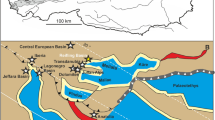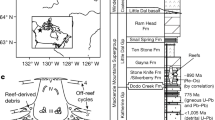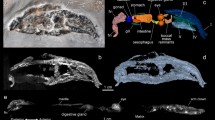Abstract
Studies of the origin and radiation of the molluscs have yet to resolve many issues regarding their nearest relatives, phylogeny and ancestral characters1,2,3,4,5,6,7,8,9,10,11. The Polyplacophora (chitons) and the Aplacophora are widely interpreted as the most primitive extant molluscs2,3,9,10, but Lower Palaeozoic fossils of the former lack soft parts, and the latter were hitherto unrecognized as fossils. The Herefordshire Lagerstätte12 is a Silurian (about 425 Myr bp) deposit that preserves a marine biota in remarkable three-dimensional detail. The external surface of even non-biomineralized cuticle was preserved by entombment in volcanic ash, subsequent incorporation into concretions, and infilling of the fossils with sparry calcite13. Here we describe, from this deposit, a complete vermiform mollusc, which we interpret as a plated aplacophoran. Serial grinding at intervals of tens of micrometres, combined with computer-based reconstruction methods, renders the fossils in the round14.
This is a preview of subscription content, access via your institution
Access options
Subscribe to this journal
Receive 51 print issues and online access
$199.00 per year
only $3.90 per issue
Buy this article
- Purchase on Springer Link
- Instant access to full article PDF
Prices may be subject to local taxes which are calculated during checkout



Similar content being viewed by others
References
Bengtson, S. The cap-shaped Cambrian fossil Maikhanella and the relationship between coeloscleritophorans and molluscs. Lethaia 25, 401–420 (1992).
Conway Morris, S. & Peel, J. S. Articulated halkieriids from the Lower Cambrian of North Greenland and their role in early protostome evolution. Phil. Trans R. Soc. Lond. B 347, 305–358 (1995).
Ivanov, D. L. in Origin and Evolutionary Radiation of the Mollusca (ed. Taylor, J. D.) 59–65 (Oxford Univ. Press, 1996).
Lindberg, D. R. in Origin and Evolutionary Radiation of the Mollusca (ed. Taylor, J. D.) 67–75 (Oxford Univ. Press, 1996).
Peel, J. S. Functional morphology, evolution and systematics of early Palaeozoic univalved molluscs. Bull. Grønlands Geol. Unders. 161, 1–116 (1991).
Rosenberg, G. et al. Ribosomal RNA phylogeny of selected major clades in the Mollusca. J. Mollus. Stud. 63, 301–309 (1997).
Runnegar, B. in Origin and Evolutionary Radiation of the Mollusca (ed. Taylor, J. D.) 77–87 (Oxford Univ. Press, 1996).
Runnegar, B. N. & Pojeta, J. in The Mollusca Vol. 10 (eds Trueman, E. R. & Clarke, M. R.) 1–57 (Academic, Orlando, 1985).
Salvini-Plawen, L. v. & Steiner, G. in Origin and Evolutionary Radiation of the Mollusca (ed. Taylor, J. D.) 29–51 (Oxford Univ. Press, 1996).
Scheltema, A. H. in Origin and Evolutionary Radiation of the Mollusca (ed. Taylor, J. D.) 53–58 (Oxford Univ. Press, 1996).
Winnepenninckx, B., Backeljau, T. & De-Wachter, R. Investigation of molluscan phylogeny on the basis of 18S rRNA sequences. Mol. Biol. Evol. 13, 1306–1317 (1996).
Briggs, D. E. G., Siveter, David. J. & Siveter, Derek. J. Soft-bodied fossils from a Silurian volcaniclastic deposit. Nature 382, 248–250 (1996).
Orr, P. J., Briggs, D. E. G., Siveter, David J. & Siveter, Derek J. Three-dimensional preservation of a non-biomineralized arthropod in concretions in Silurian volcaniclastic rocks from Herefordshire, England. J. Geol. Soc. Lond. 157, 173–186 (2000).
Sutton, M. D., Briggs, D. E. G., Siveter, David J. & Siveter, Derek J. Methodologies for the visualization and reconstruction of three-dimensional fossils from the Silurian Herefordshire lagerstätte. Paleontol. Electronica (in the press).
Cherns, L. Silurian polyplacophoran molluscs from Gotland, Sweden. Palaeontology 41, 939–974 (1998).
Cherns, L. Chelodes and closely related Polyplacophora (Mollusca) from the Silurian of Gotland, Sweden. Palaeontology 41, 545–573 (1998).
Wingstrand, K. G. On the anatomy and relationships of Recent Monoplacophora. Galathea Rep. 16, 7–94 (1985).
Acknowledgements
This work was supported by NERC. We acknowledge technical assistance by J. Hay, and we thank L. Cherns, J. Peel and J. Taylor for discussions.
Author information
Authors and Affiliations
Corresponding author
Rights and permissions
About this article
Cite this article
Sutton, M., Briggs, D., Siveter, D. et al. An exceptionally preserved vermiform mollusc from the Silurian of England. Nature 410, 461–463 (2001). https://doi.org/10.1038/35068549
Received:
Accepted:
Issue Date:
DOI: https://doi.org/10.1038/35068549
This article is cited by
-
Taphonomy of non-biomineralized trilobite tissues preserved as calcite casts from the Ordovician Walcott-Rust Quarry, USA
Communications Earth & Environment (2023)
-
A mitogenomic phylogeny of chitons (Mollusca: Polyplacophora)
BMC Evolutionary Biology (2020)
-
Ancestral morphology of crown-group molluscs revealed by a new Ordovician stem aculiferan
Nature (2017)
-
Cuticle of Polyplacophora: structure, secretion, and homology with the periostracum of conchiferans
Marine Biology (2017)
-
A Silurian armoured aplacophoran and implications for molluscan phylogeny
Nature (2012)
Comments
By submitting a comment you agree to abide by our Terms and Community Guidelines. If you find something abusive or that does not comply with our terms or guidelines please flag it as inappropriate.



